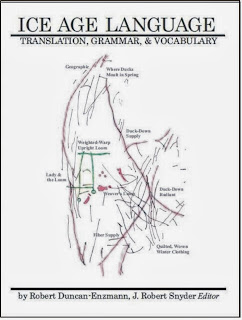Our ancestors had abilities and knowledge that generally go unrecognized. The symbols they created carry stories of their social structures, medicines, home life, families, trade, struggles, and victories. They documented their knowledge and history with symbols - images combined with oral tradition, passed on from old to young. Engraved on the great continental megalithic village utilities as well as on small stones, ivory, and bones, the information was recorded for future generations. Some of our oldest Faerie tales and mythologies carry the memory and history of these ancestors.
In order to decode symbols, we must understand why they were made. Conventional opinion states that prehistoric art is just that: art for art’s sake, or ritual and magical art. However, the images left us by our ancestors have real stories to tell. A physicist and cryptographer, Dr. Robert Duncan-Enzmann, has translated thousands of inscriptions from 14,500 years ago, a language used by our ancestors during an iron cold ice age of the Paleolithic Era. Images inscribed on stone, bone, and ivory depict every day activities of child care, housing, clothing, and calendrics. Paintings of animals depict calendrics describing migrations, seasons, and what part of the animal to use for what purpose.
The picture-story in image A is about the birth of Lorelei, a Rhine maiden. Lorelei’s birth was certainly written (scratched in stone) by a lady of a small hunting family or clan. Labeled on the image: numbers 16 & 1 indicate the pregnant mom, 21 the baby born, connected by umbilical cord (in red), and 22 - horses that bless baby with hair for warmth and bones for fat: the Horse Spirit blesses baby’s spirit. Lorelei is the beginning of the sun-child, sun-goddess mythology.
The right clothing was essential for survival in an ice age. Spinning and weaving have roots in Paleolithic family clans. Duncan-Enzmann’s translations bring to us records of women making and trading textiles. He says: “Much, indeed most of the Magdalenian writings concern textiles; likely all of it written by women. Their writings show that today’s most personal and important comforts of home were invented and used well over 14,500 years ago. Long before we had electricity, ancient versions of heating, laundry, child care, cooking, and lighting - all of these necessities existed in other forms”. Image B is an inscription showing a woman at a weighted-warp upright loom, with her oil lamp on the floor.
Paleolithic mothers taught their daughters the art of spinning; little girls spun, mothers wove, and grannies tailored. While the women worked they told stories to pass on knowledge to their children (thus “spinning a yarn”). These generational practices led to the mythology of Maiden, Mother, and Crone as Norns working the threads of life in time. (Norns spin the thread of fate at the foot of Yggdrasil – the Tree of Life - weaving the pattern of destiny for both gods and men.) Diagrams were carefully made of what to use for weaving, when to extract aspirin from willow branches, and how to sharpen needles. Image C instructs how to make boots.
These artifacts, scraps surviving from our past, represent a great treasure. They provide valuable information and a tangible link to our ancestors. Some of the most intriguing and mysterious symbols of today have roots in prehistory; decoding them is possible in part because we have translations of this ice age language. When symbols are put in historic context our understanding of human development becomes more accurate, and our decoding of symbolic imagery is more profound.
Dr. Duncan-Enzmann's translations have been compiled and published by J. Robert Snyder, and are now available at Amazon!

.jpg)





No comments:
Post a Comment